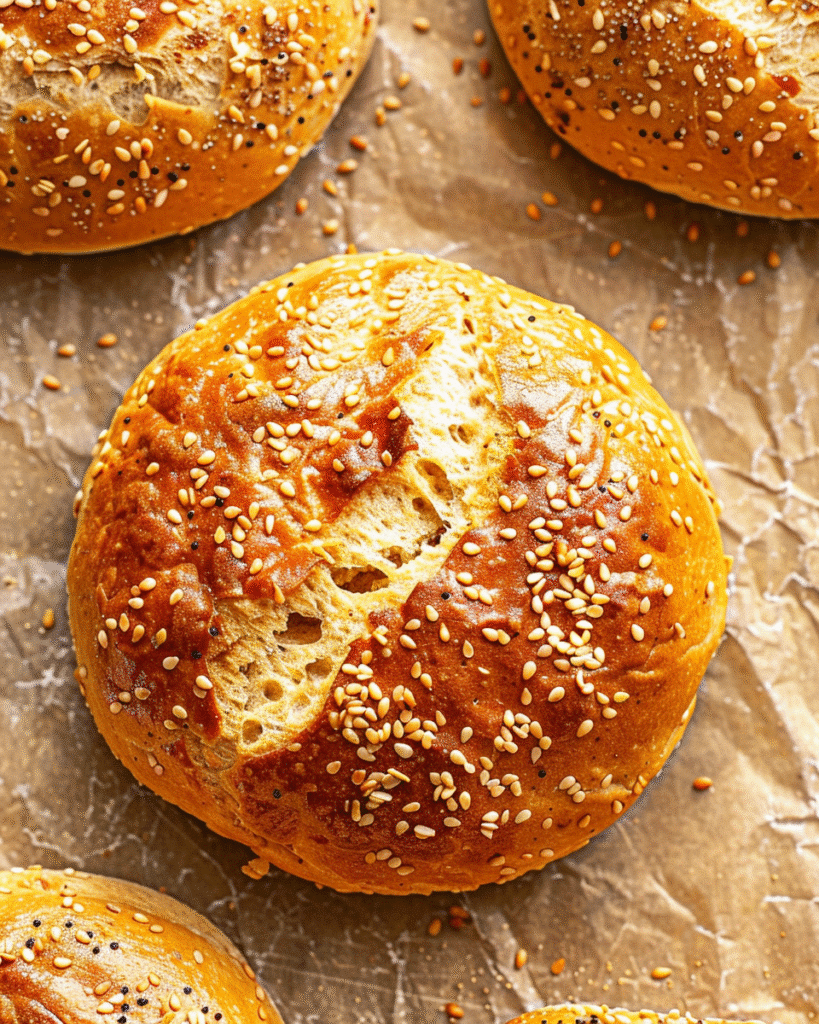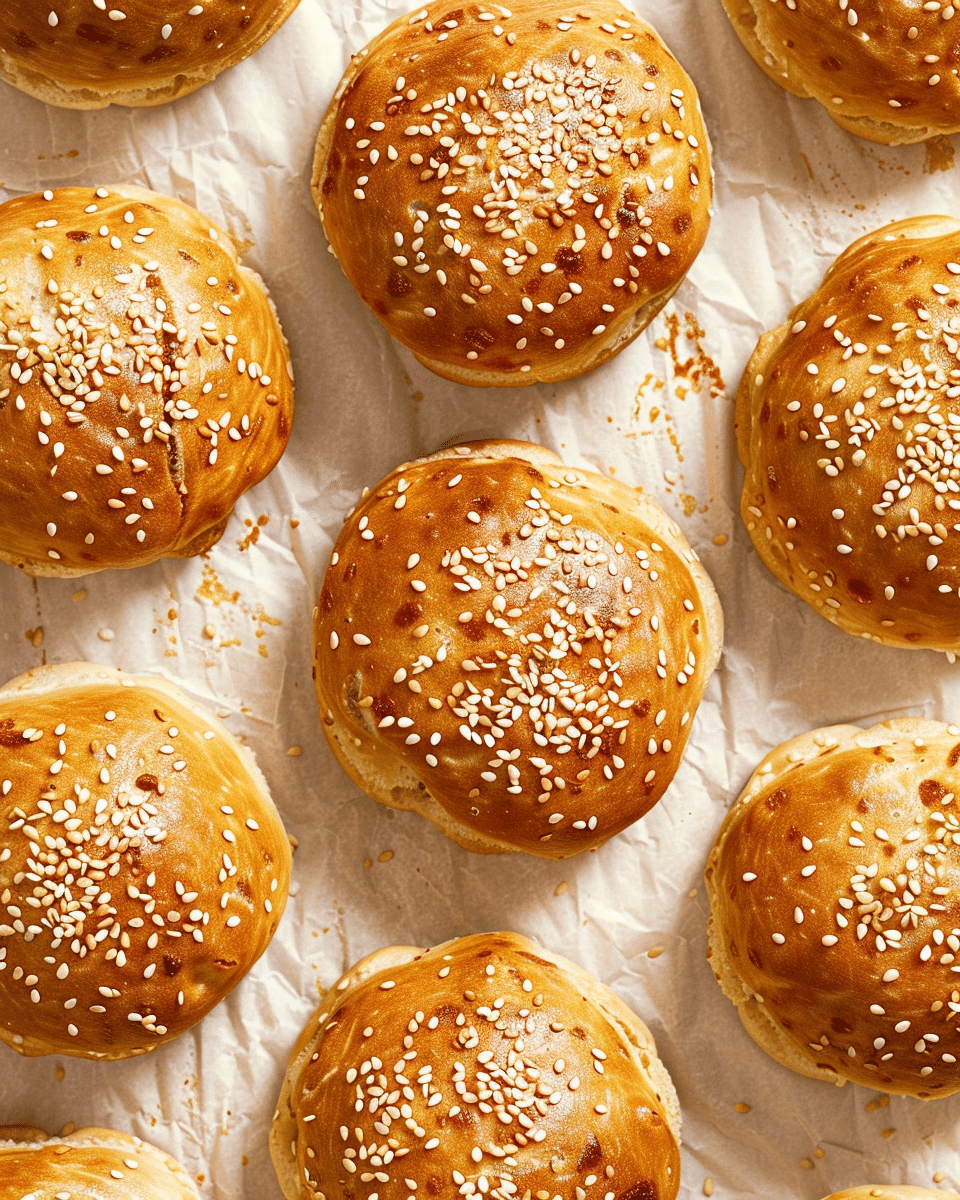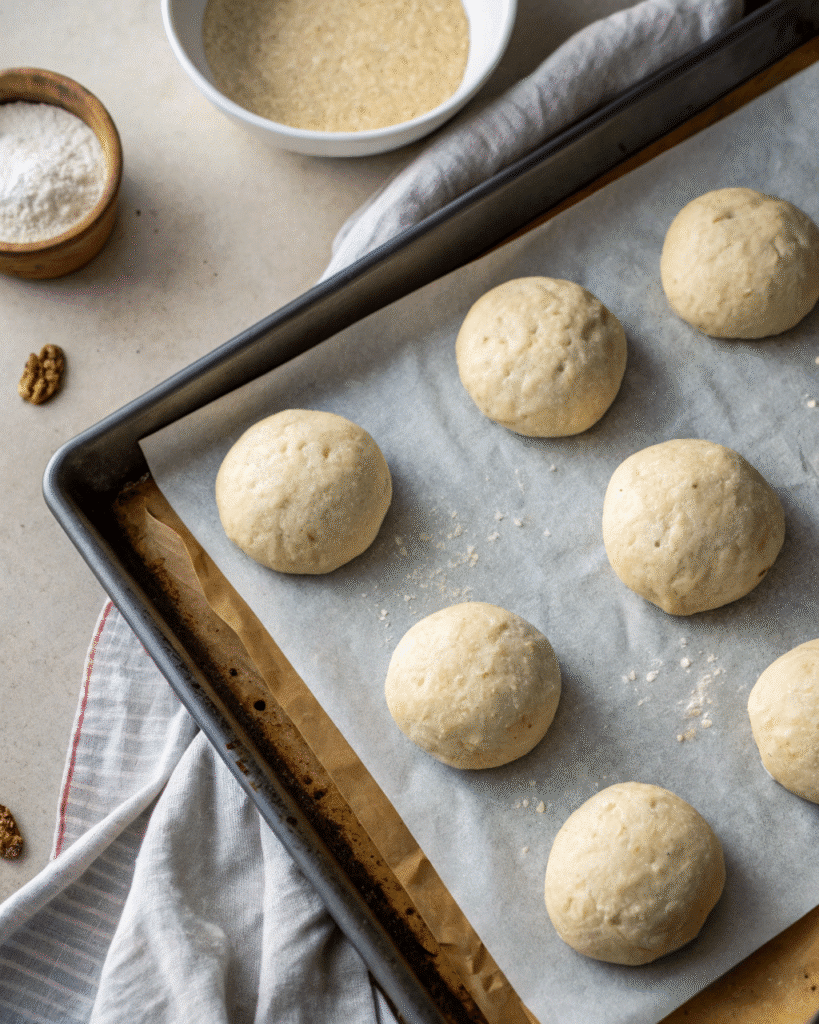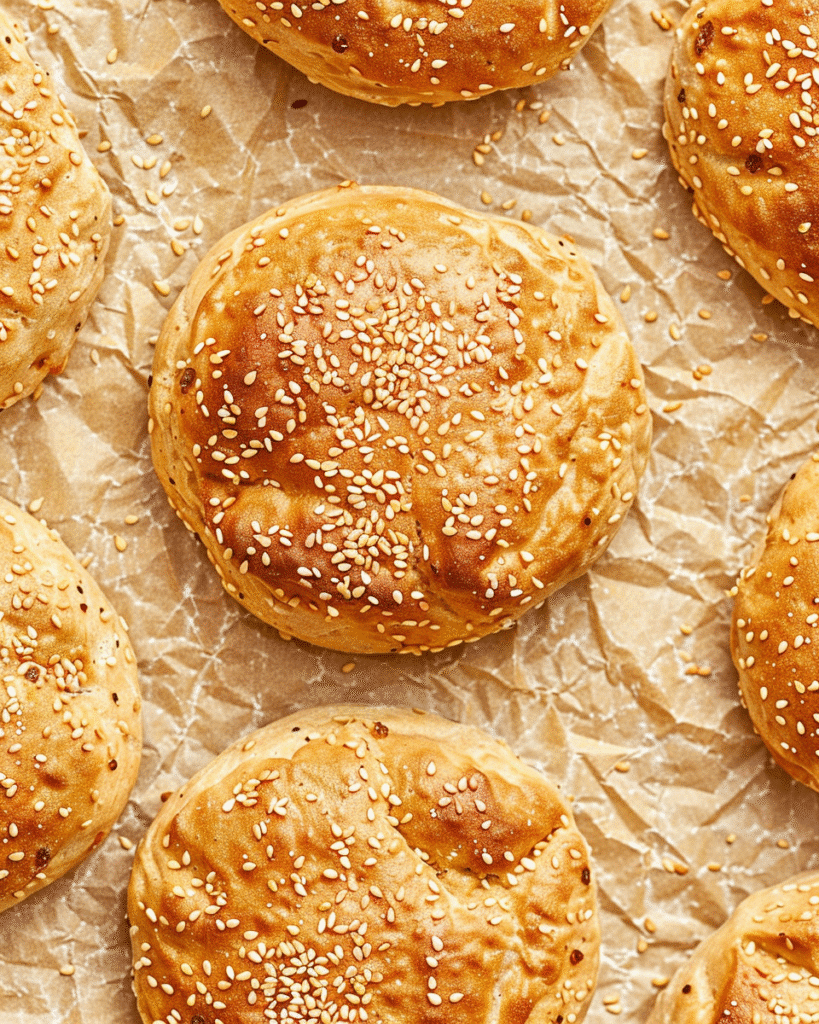Gluten free hamburger buns bring back some of my favorite childhood memories. I can still remember the scent of fresh bread at family cookouts — soft buns stacked next to the grill, ready to hold thick, juicy burgers. Back then, no one worried about gluten. Today, we know better, and the good news is that we don’t have to sacrifice flavor or texture to enjoy amazing gluten-free options.
If you’re on the hunt for the perfect gluten free hamburger buns, whether because of celiac disease, gluten intolerance, or a desire for healthier choices, you’re in the right place. These buns have come a long way. Modern gluten-free baking means you can have a soft, fluffy bite that rivals any traditional bun, and the best part? They’re easy to make and even easier to find.
In this guide, we’ll explore what makes gluten free hamburger buns special, the best ingredients to use, expert tips for perfect results, and creative ways to enjoy them beyond the classic burger. Plus, we’ll debunk common myths and answer the most frequently asked questions to help you choose — or bake — the best buns every time.
Ready to discover how gluten free hamburger buns can transform your next meal? Let’s dive in.

Learn more about our gluten-free baking secrets!
Table of Contents
Table of Contents
Understanding Gluten Free Hamburger Buns
What Are Gluten-Free Hamburger Buns?
Gluten free hamburger buns are crafted without the traditional grains like wheat, barley, or rye — the usual culprits behind gluten. Instead, they’re made with clever blends of rice flour, almond flour, or certified gluten-free flour mixes that often include xanthan gum to create that classic chewy texture.
These buns have evolved way beyond the dry, crumbly alternatives of the past. Thanks to advancements in gluten-free baking, today’s buns can match — and sometimes even beat — traditional versions when it comes to softness and flavor. Plus, many options are also dairy-free and allergen-friendly, making them a fantastic choice for a wider range of dietary needs.
Whether you’re avoiding gluten for health reasons or simply aiming for a lighter bite, gluten free hamburger buns are no longer a compromise; they’re a delicious upgrade.
Key Differences Between Regular and Gluten-Free Buns
There’s more than meets the eye when comparing traditional buns with gluten free hamburger buns:
- Texture: Traditional buns get their signature chew from gluten. Gluten-free versions rely on a precise mix of starches and gums to replicate that structure.
- Flavor: Without gluten, bakers can highlight alternative flours like sorghum or millet, adding subtle, nutty notes that enrich the taste.
- Shelf Life: Gluten helps retain moisture, so gluten-free buns need a bit more care. Proper baking techniques keep them soft and satisfying for longer.
- Nutrition: Many gluten-free options bring additional nutrients, with higher fiber and protein levels, especially when made from whole grain blends.
Once considered second-best, gluten free hamburger buns today prove you can have both taste and texture without compromise.

Gluten Free Hamburger Buns: Your Ultimate Guide to Fluffy, Flavorful Buns
Ingredients
Method
- In a large mixing bowl, combine the gluten-free flour, sugar, yeast, and salt.
- Add the lukewarm water, melted butter, and eggs. Mix until a sticky dough forms (about 2–3 minutes).
- Transfer the dough to a lightly greased bowl, cover, and let it rise in a warm place for about 1 hour, until doubled in size.
- Gently deflate the dough and divide it into 6 equal portions. Shape each portion into a smooth ball and place them on a parchment-lined baking sheet.
- Cover and let the shaped buns rise for another 30–45 minutes until slightly puffed.
- Preheat your oven to 375°F (190°C).
- Prepare an egg wash by beating one egg with 1 tablespoon of water. Brush the tops of the buns and sprinkle with sesame seeds or poppy seeds if desired.
- Bake for 15–20 minutes or until the tops are golden brown.
- Remove from the oven and brush with melted butter while still warm for extra flavor and softness.
- Let the buns cool completely on a wire rack before slicing and serving.
Nutrition
Notes
Tried this recipe?
Let us know how it was!Benefits of Choosing Gluten Free Hamburger Buns
Health Advantages of Gluten-Free Diets
Gluten-free living has come a long way from being just a medical necessity for people with celiac disease. Many individuals today choose a gluten-free diet for a variety of health benefits.
For starters, eliminating gluten can reduce bloating and digestive discomfort, even in people without diagnosed gluten intolerance. A gluten-free diet often encourages eating more whole foods like fruits, vegetables, and lean proteins, leading to an overall healthier lifestyle.
When you swap traditional buns for gluten free hamburger buns, you’re also avoiding highly processed flours that can spike blood sugar levels. Instead, gluten-free buns often incorporate nutrient-rich flours like brown rice or almond, offering more fiber, vitamins, and minerals.
Some people report better focus, reduced joint pain, and increased energy after cutting out gluten — small changes that can make a big impact over time.
Why Gluten-Free Buns Are a Better Choice for Many
Beyond health, gluten free hamburger buns simply open up more inclusive dining experiences. They’re a must-have for families where one or more members have gluten sensitivity or celiac disease. No one should miss out on burger night!
Choosing gluten-free options also caters to guests with multiple food allergies. Many brands and recipes are not just gluten-free but also free from dairy, nuts, and soy, making them safer for a broader range of diets.
Plus, let’s face it — homemade or well-crafted gluten-free buns often have a richness and slight nuttiness that regular white buns just can’t match. With a little attention to quality, gluten free hamburger buns transform your meal into something even more special and thoughtful.
How to Make Gluten Free Hamburger Buns at Home
Essential Ingredients You’ll Need
Making gluten free hamburger buns at home starts with the right ingredients — the foundation for buns that are tender, airy, and flavorful. Here’s what you’ll need:
- Gluten-Free All-Purpose Flour: Look for blends with xanthan gum included, like Better Batter or Pillsbury Gluten-Free, designed for yeast baking.
- Granulated Sugar: A little sweetness feeds the yeast, helping the buns rise perfectly.
- Instant Yeast: Speeds up the rising process and ensures your buns are fluffy.
- Salt: Essential for enhancing flavor.
- Water: Lukewarm, around 100°F, to activate the yeast without killing it.
- Butter: Regular or dairy-free — it enriches the dough, giving it a soft texture.
- Eggs: Add richness and help bind the dough, also giving that glossy, golden crust.
- Toppings (Optional): Sesame or poppy seeds add a nice crunch and classic look.
These ingredients work together to mimic the stretch and softness that gluten normally provides, creating buns that hold up to your juiciest burgers.

Step-by-Step Process to Bake Perfect Buns
Here’s a simple roadmap to homemade success:
- Mix Dry Ingredients: In a large bowl, whisk together the gluten-free flour, sugar, yeast, and salt.
- Add Wet Ingredients: Pour in the lukewarm water, melted butter, and beaten eggs. Mix until a sticky dough forms — this should take about 2-3 minutes.
- First Rise: Transfer the dough to a lightly greased bowl, cover it, and let it rise in a warm place for about one hour until it doubles in size.
- Shape the Buns: Gently deflate the dough and divide it into six equal portions. Shape each into a ball and place them on a parchment-lined baking sheet.
- Second Rise: Cover the buns again and let them rise for 30-45 minutes until slightly puffed.
- Preheat Oven: While the buns rise, preheat your oven to 375°F.
- Prepare for Baking: Brush the tops with an egg wash (one egg beaten with a tablespoon of water). Sprinkle with sesame or poppy seeds if desired.
- Bake: Bake for 15-20 minutes or until golden brown.
- Finish and Cool: Brush the hot buns with melted butter for extra flavor and softness. Let them cool on a wire rack before slicing.
Pro Tip: Measure your flour using the spoon-and-level method to avoid adding too much and ending up with dry buns!
There’s something incredibly satisfying about biting into a burger stacked high between two homemade gluten free hamburger buns. The smell, the texture — it all feels like an upgraded, healthier version of those classic backyard memories.
Don’t miss our gluten-free pancake recipe for another easy, homemade treat!
Tips for Baking the Best Gluten Free Hamburger Buns
Common Mistakes and How to Avoid Them
Baking gluten free hamburger buns at home is incredibly rewarding, but even the best recipes can go sideways without the right techniques. Let’s talk about some common pitfalls:
- Overworking the Dough: Unlike traditional doughs that benefit from kneading, gluten-free doughs can get tough if overmixed. Gentle handling is key to a soft, fluffy bun.
- Wrong Flour Blend: Not all gluten-free flours are created equal. Always use a blend recommended for yeast baking, and make sure it includes a binder like xanthan gum.
- Skipping the Rise: Yeast needs time to work its magic. Rushing the proofing step will leave your buns dense and flat.
- Incorrect Water Temperature: If your water’s too hot, it can kill the yeast; too cold, and it won’t activate properly. Aim for warm water — around 100°F.
- Measuring Flour Incorrectly: Always spoon flour into the measuring cup and level it off. Scooping directly from the bag can pack it down, throwing off the balance.
Avoid these mistakes, and you’re already halfway to perfect gluten free hamburger buns.

Secrets for Getting That Fluffy Texture
Creating buns that are light and airy — not heavy and crumbly — is all about technique and ingredients. Here are the secrets:
- Room Temperature Ingredients: Cold eggs or butter can interfere with how the dough rises. Let your ingredients come to room temperature first.
- Moisture Balance: Gluten-free dough tends to be stickier — don’t panic. Resist the urge to add more flour; trust the recipe.
- Double Rising: That second rise after shaping is critical. It ensures a final burst of lift that keeps the buns fluffy once baked.
- Egg Wash: Brushing the tops with an egg wash not only gives a beautiful golden color but also locks in moisture.
- Steam in the Oven: Place a small oven-safe dish of water in the oven while baking. The steam will help create a soft crust, making the interior tender.
With these small tweaks, your gluten free hamburger buns can rival — or even beat — their gluten-filled cousins in both taste and texture.
Best Flours for Gluten Free Hamburger Buns
Choosing the Right Gluten-Free Flour Blend
The secret behind soft and airy gluten free hamburger buns lies in the flour blend. Not all gluten-free flours behave the same way when mixed with yeast. Some are too dense; others don’t rise properly. That’s why a good blend matters.
Look for all-purpose gluten-free blends specifically designed for baking with yeast. These blends usually combine flours like:
- Brown Rice Flour
- Sorghum Flour
- Tapioca Starch
- Potato Starch
Brands like Better Batter and Pillsbury Gluten-Free are top picks because they maintain a good balance of structure and softness.
Why Xanthan Gum Is Essential
Without gluten, the dough needs something to hold it together and create elasticity. That’s where xanthan gum comes in.
Xanthan gum acts as a binding agent, mimicking gluten’s stretchiness. It traps air bubbles created by yeast, helping the dough rise and giving your buns that essential chewiness.
If your flour blend doesn’t include xanthan gum, be sure to add it separately. Typically, one teaspoon per cup of flour does the trick.
Using the right flour and xanthan gum ensures your gluten free hamburger buns will be fluffy and satisfying — not dense or crumbly.
How to Customize Gluten Free Hamburger Buns
Adding Seeds, Herbs, and Flavor Twists
One of the best parts about making gluten free hamburger buns at home is the ability to customize them to your taste. Why settle for plain when you can get creative?
Here are a few ideas:
- Seeds: Sprinkle sesame, poppy, or flax seeds on top before baking for extra crunch and flavor.
- Herbs: Mix dried rosemary, thyme, or oregano into the dough for an herby twist perfect for gourmet burgers.
- Spices: Add a hint of garlic powder or onion powder to the dough for subtle savory notes.
- Cheese Toppings: If you’re not dairy-free, shredded parmesan or cheddar sprinkled on top adds a rich flavor layer.
These little additions turn your basic gluten free hamburger buns into standout stars, making even a simple burger feel elevated.
Making Vegan or Dairy-Free Variations
It’s easy to tweak the classic recipe to fit a dairy-free or vegan diet without sacrificing taste or texture:
- Butter Substitutes: Use dairy-free butter or even olive oil for richness.
- Egg Replacements: Flax eggs (1 tablespoon ground flaxseed + 3 tablespoons water) work well for binding and moisture.
- Milk Alternatives: If your recipe calls for milk, swap it with unsweetened almond milk or oat milk.
These adjustments keep your buns soft, fluffy, and flavorful, all while fitting into a variety of dietary needs. Customizing your gluten free hamburger buns ensures that everyone at your table can dig in, no matter their restrictions.
Discover great ideas like easy 4-ingredient gluten-free biscuits if you love simple, customizable baking.
Common Myths About Gluten-Free Baking
Gluten-Free Buns Are Always Dry: Myth Busted
One of the biggest myths about gluten free hamburger buns is that they’re destined to be dry and crumbly. Truth is, when made correctly, they can be just as soft and pillowy as any traditional bun — maybe even better!
The key lies in using the right moisture balance and choosing a good flour blend. Recipes today include ingredients like eggs, butter (or dairy-free alternatives), and even yogurt to lock in moisture. Plus, smart baking techniques, like not overworking the dough and allowing for proper rising time, make a huge difference.
Forget what you’ve heard — dry buns are a thing of the past when you follow modern gluten-free baking methods.
You Can’t Get a Good Rise Without Gluten
Another misconception is that you can’t achieve a fluffy, risen bun without gluten. Not true. Gluten free hamburger buns can rise beautifully with a little help from instant yeast and structure-builders like xanthan gum.
Yeast doesn’t depend on gluten to create gas bubbles; it needs a stable dough structure, and that’s exactly what modern gluten-free recipes provide. With the right mix and careful proofing, your buns will be light, airy, and hold their shape just as well as traditional ones.
Today’s gluten-free baking world has completely flipped the script, proving that good rise and great texture are very much possible.
Storage and Freezing Tips for Gluten Free Hamburger Buns
How to Keep Your Buns Fresh
Homemade gluten free hamburger buns are best enjoyed fresh, but with a few smart tricks, you can extend their life without losing quality. Here’s how to keep them soft and tasty:
- Room Temperature Storage: Store buns in an airtight container at room temperature for up to two days. Keep them away from direct sunlight and heat to prevent drying out.
- Moisture Control: Add a small piece of parchment paper inside the container to absorb excess moisture and prevent sogginess.
- Reheat Before Serving: A quick 10-second zap in the microwave brings them back to life — soft, warm, and ready for your burger creations.
Best Ways to Freeze and Reheat
Want to make a bigger batch and save some for later? No problem. Freezing gluten free hamburger buns is simple and keeps them delicious:
- Cool Completely: Let the buns cool fully on a wire rack to prevent ice crystals.
- Wrap Individually: Wrap each bun tightly in plastic wrap or foil.
- Store in a Freezer Bag: Place the wrapped buns in a large zip-top freezer bag, squeezing out as much air as possible.
- Label and Date: Always label your bag with the freeze date — buns stay best for up to three months.
When you’re ready to enjoy, thaw the buns at room temperature or give them a few seconds in the microwave. For a crispier texture, pop them in a toaster oven for a couple of minutes.
With the right storage methods, your homemade gluten free hamburger buns will be just as fresh and satisfying as the day you baked them.

Serving Suggestions and Creative Ideas
Best Burgers to Pair with Gluten-Free Buns
Sure, a classic beef burger is a natural fit, but gluten free hamburger buns can handle so much more. Here are a few burger ideas to elevate your next meal:
- Turkey Burgers: Lean but flavorful, turkey patties pair perfectly with the soft texture of gluten-free buns.
- Veggie Burgers: A black bean or quinoa burger finds the perfect companion in a bun that won’t crumble or overpower.
- Salmon Burgers: For a lighter option, pair a salmon patty with a dill sauce and crispy lettuce.
- Chicken Burgers: Grilled chicken, a slice of avocado, and a fresh tomato make for a simple, fresh bite.
- Portobello Mushroom Burgers: Roasted mushrooms marinated in balsamic vinegar and herbs are a vegetarian dream when tucked inside a fluffy bun.
Each one of these options lets the bun shine, holding up to juicy fillings without getting soggy or falling apart.
Other Creative Ways to Use Gluten-Free Buns
Don’t stop at burgers — gluten free hamburger buns are versatile! Here are a few more ways to enjoy them:
- Breakfast Sandwiches: Add scrambled eggs, cheese, and a slice of bacon for a hearty start to your day.
- Mini Pizzas: Slice the buns in half, add sauce, cheese, and toppings, and bake until bubbly.
- Pulled Pork Sliders: Perfect for game day, these buns can easily be turned into slider buns with a simple size adjustment.
- Garlic Bread: Brush with butter and garlic, then toast in the oven for a quick and delicious side.
- Sandwich Rolls: Pile them high with deli meats, cheese, and veggies for lunch on the go.
With a batch of fresh gluten free hamburger buns, the possibilities stretch far beyond burgers, making them a kitchen staple you’ll turn to again and again.
Looking for inspiration? Try these crispy baked BBQ chicken thighs for a perfect burger-night side!
Conclusion
Choosing the right gluten free hamburger buns doesn’t have to be complicated. Whether you decide to make them at home with a few pantry staples or grab a trusted brand from your local store, you can enjoy buns that are soft, flavorful, and satisfying — no compromises needed.
Homemade buns give you full control over ingredients, allowing for endless customization, while store-bought options are now better than ever, catering to various dietary needs. Remember, the key to success lies in the flour blend, proper dough handling, and a little patience during the rise.
With these tips, tricks, and ideas, you’re all set to upgrade your next burger night with buns that everyone — gluten-free or not — will love. So go ahead and fire up that grill, because with the perfect bun in hand, every bite just gets better.
Don’t miss our gluten-free chicken tenders for another family-friendly gluten-free meal idea.
Follow us on Facebook & Pinterest for more gluten-free dessert ideas and community fun!
For more delicious gluten-free recipes, visit our website at The Savory Hearth.
FAQ
Where to buy gluten free hamburger buns?
Finding quality gluten free hamburger buns is easier than ever. Many grocery stores like Whole Foods, Kroger, and Walmart carry trusted brands such as Udi’s, Canyon Bakehouse, and Schär. If you prefer shopping online, sites like Amazon and Thrive Market offer a broad selection, often with customer reviews to help you pick the best one. Always look for certified gluten-free labels to ensure safety and quality.
How to make gluten free hamburger buns?
Making gluten free hamburger buns at home is straightforward with the right ingredients. Start with a reliable gluten-free all-purpose flour blend that includes xanthan gum. Mix it with instant yeast, sugar, salt, lukewarm water, butter, and eggs. After allowing the dough to rise, shape it into buns, let it proof again, and bake until golden brown. Customize with toppings like sesame seeds or herbs for an extra touch.
Are hamburger buns gluten free?
Most traditional hamburger buns are not gluten-free since they’re made with wheat flour, which contains gluten. However, specially made gluten free hamburger buns use alternative flours like rice, sorghum, or almond and are designed to replicate the texture and taste of traditional buns without any gluten. Always check for certified gluten-free labeling if you’re buying pre-made buns.
Are potato hamburger buns gluten free?
Potato buns sound like a safe bet, but many still contain wheat flour alongside potato flour, meaning they’re not naturally gluten-free. However, some brands offer gluten-free versions of potato buns specifically crafted without any gluten-containing ingredients. If you love that tender, slightly sweet flavor of potato buns, check labels carefully or opt for recipes that use gluten-free flour blends with potato starch.
